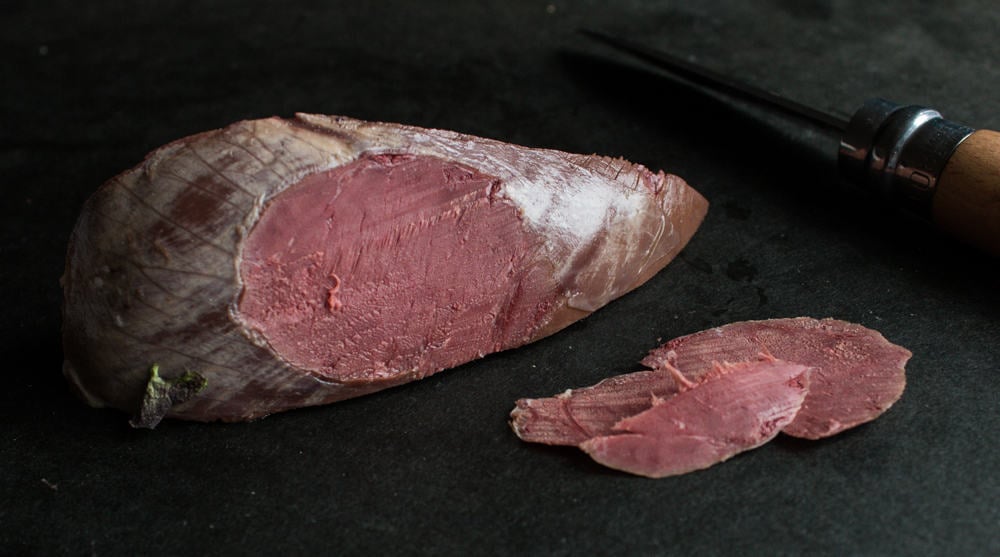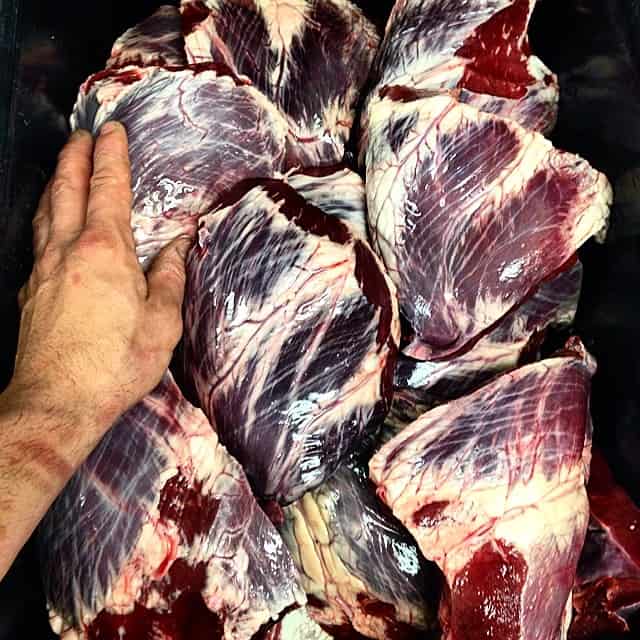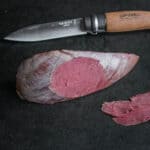Corning can be a good way to treat deer hearts, and it makes a great venison hash. Read on and I'll explain the details.

At Thanksgiving this year, I was wandering around my girlfriend's family farm in Wisconsin. I went outside to check on someone when I spotted something sitting on the grill outside (it's cold enough at thanksgiving to refrigerate things outdoors, as most people who've brined a turkey in the Midwest know).
Sitting on the grill was large, fresh heart. Thanksgiving coincides with deer season and I knew exactly what I was looking at. My mouth started to water thinking about corned heart, one of my favorite ways to cook that special part of a big animal.

I asked around and found that someone had put the heart on the grill and forgotten about it outside, so I asked politely if I could bring it home to cook, which I was happy to do in exchange for some turkey carving.
You can corn any heart, not just deer
Corned heart and I started a number of years ago when the butcher at the restaurant I worked at that specialized in whole animals spoke with our meat purveyor and got a deal on beef hearts (not a hard thing to do).
I walked in one day to 60 lbs of beef heart in the fridge and started to frantically think of how we could ever use so much before it turned, and without re-freezing it raw. I don't think the butcher knew what he was ordering at all, he was a weird guy all around, I mean even for a 300 seat restaurant we were, that's a lot of heart.

Out of the "bounty" of that delivery I decided try corning them, I thought I was pretty smart, but smart hunters and inventive butchers have been doing it for a long time. The beauty of corning is that the meat needs to sit and cure in a brine, which also prevents it from spoiling. The high amount of salt in the brine preserves the meat and puts it in a sort of stasis, while transforming the texture and flavor.
After the meat is "cooked" by the brine, you simmer it slowly until tender. What you're left with is a meat that's been heavily cured and can even withstand a lengthy stay in the freezer just like ham.
In the case of heart and other organs you might corn (tongue, testicles) brining does the double duty of purging a bit of the gamey flavor people associate with organs and smoothing out flavors a bit, just like you might soak livers, sweetbreads, kidneys or brains in milk or salt water before cooking.
How to Enjoy
What you end up with is a great substitute for corned beef, I've made all sorts of stuff with it: shaved thin it makes mind altering rueben and of course a wicked corned heart hash.
It's also great just shaved thin and eaten with cheese, crackers and butter, but if you're in a restaurant, I recommend the meat be shaved daily on a rotary slicer and kept wrapped tightly in plastic between sheets of parchment because the high amount of iron and lack of fat means the meat will quickly dry and oxidize while it's waiting to go on a charcuterie board or wherever it's home will be.
Corned Venison Heart
Ingredients
- Brine ingredients
- ½ gal (roughly 1900 g) water
- ½ cup +2 Tablespoons (170g) kosher salt
- ¼ cup (57 g) sugar
- ½ ounce (14 g) or roughly 2.5 teaspoons pink curing salt sodium nitrite
- 4 Tablespoons pickling spice
- 3-4 fresh or frozen venison hearts
- For the final cooking
- 1 each roughly chopped: medium sized carrot, 2 celery stalks, one small yellow onion
- 2 tablespoons chopped fresh garlic
- 2 tablespoons chopped fresh ginger
Instructions
- Toast the spices over low-medium heat until aromatic then wrap in cheesecloth for easy removal (optional). Bring the spice bouquet and the brine ingredients to a simmer, then chill until cooled completely to room temperature.
- Add the halved venison heart(s) to the brine and store in a container so that the heart is completely submerged, using weights like plates to hold it underneath the brine if needed to ensure proper infusion. Refrigerate the hearts in brine. Allow the heart to cure in the brine for at least 5 days, making sure to turn the pieces of heart around here and ther to promote penetration.
- To cook, remove the hearts from the brine, discard the brine. Combine the carrot, onion, celery, garlic and ginger and the heart and cover with water.
- Bring the mixture to a simmer, then turn the heat down low and cook gently for 1.5 hours, or until the heart is tender.
- Afterwords, cool the heart in it's cooking liquid, then transfer to a labeled, dated container and reserve until needed. If you don't want or have space to store the heart in it's liquid, wrap it tightly in plastic wrap, then place in a larger, seal-able bag or vacuum pack. I like to use within a week, but it also freezes really well due to the curing process, just like conventional ham.
Notes

Corned Venison Heart-Heirloom Potato Hash
A simple hash made from corned venison heart and potatoes. Serves 2 as a side dish, double the portions for a breakfast entree.Servings: 2Ingredients
- 1 lb mixed heirloom potatoes
- 1 cup corned venison heart diced ¼ inch
- 3 tablespoons oil or lard
- Kosher salt and fresh ground black pepper to taste
Instructions
- Preheat an oven to 350, then roast the potatoes until just tender. Cool the potatoes, then peel and dice ¼ inch, you should end up with about 2 cups.
- In a bowl, toss the potatoes with the diced venison heart thoroughly, you don't want to make mashed potatoes, but don't be afraid to smush it a bit to cover everything with a decent layer of starch, which helps make the crusty part everyone loves about hash.
- Heat the oil or lard in a cast iron skillet or other non-stick pan until lightly smoking. Add the potato-heart mixture, season lightly with salt and pepper, then press the mixture down and cook on medium-low heat until a golden brown crust forms on the bottom and the mixture moves as one, about 5 minutes.
- Carefully flip the mixture if you're adept at flipping things in pans, or alternately use the safe and less exciting way of inverting the hash onto a plate, then sliding back into the pan to cook the other side and form a crust. When a nice crust has formed on the other side, the hash is ready, carefully transfer to a plate(s) and serve immediately.


Timothy
I'm finding confusing info for sodium nitrate vs Prague powder (assuming you're referencing #1).
It seems like Prague powder #1 is limited to 6.25% sodium nitrate, the rest is sodium chloride (generic salt). Is your recipe targeting 184g total salt, 14 of which is sodium nitrate 7.6% final ratio, or 170g salt, 14g of 6.25% sodium nitrate, so 0.875g sodium nitrate total. It seems like pure sodium nitrate does not get the pink dye (but I'm not sure if that's what actually makes the pink color in the meat).
If all I can get is Prague #1 then should I just go with 184g of it based on the above recipe?
Alan Bergo
Prague powder is what you use, that’s the same as instacure no1. DO NOT use 184 g of it as that would be unsafe. Please follow the recipe.
Timothy
Ok, your reply combined with https://kosherdosher.blogspot.com/2020/07/curing-notes-and-some-math.html makes a lot more sense. "½ ounce (14 g) or roughly 2.5 teaspoons pink curing salt sodium nitrite" made it seem like you had special 100% sodium nitrite, rather than pink salt being 6.25% sodium nitrite, the rest sodium chloride. Didn't realize the targeted dilution wanted to be so low for sodium nitrite - PPM level, not parts per thousand.
Alan Bergo
Yes a good rule of thumb to remember is you will use 1 teaspoon of instacure #1 per 5 lbs of meat. The catch here is that more is needed with liquids which is why the amount is higher.
Christopher Miller
I'm trying your corned heart recipe and it's ready to come out of the brine, I put a roast in from last year in there as well. My one chef friend is running his smoker all day and told me I could throw that stuff on if I wanted. Would you smoke them first then simmer them in the stock? Or follow the recipe as is and finish with smoking
Alan Bergo
Hi Chris. Hearts are extremely lean, so what I would do is smoke them for an hour or so at 225F, then remove them and simmer in liquid until fork tender to keep them moist.
Liz
Made this last weekend and it was amazing. Served it on crackers sliced super thin with a good horseradish mustard and sharp cheddar.
Alan Bergo
Hey thanks Liz, glad it worked for you. Perfect way to serve it too.
Edward Main
Greetings from Auckland New Zealand !
Can you please assist with my observations and questions about the preparation and cooking of organ meats
Circumstances refer:
I stumbled across your you tube clip about corning lamb heats a few years ago.
I like the idea of organ meats as a viable protein alternative and have been experimenting ever since. Accordingly you opinions would be greatly appreciated
Brining with a 5% salt solution for 3 to 6 hours - I have found this cleans heart of excess blood.
So would brining kidney and liver embellish or detract from the overall taste?
I prefer cooking organ meats in the heart fat of their species as I think it embellishes flavour.
If I had to use cooking oils, which would you recommend?
And lastly, what are some spices that can ‘tone down ‘ the aftertaste of liver and kidney?
Thanks for your time
Alan Bergo
Hi Edward, I'm going to try to answer these as succinctly as I can.
Organ meats are absolutely a viable protein source-there's no question about that.
Brining liver and kidneys will transfer some of their flavor to the brine, so yes. With animals that have strong tasting organs, like goat or venison, I may soak the liver, whole or cut into large pieces in multiple changes of water to cover by 2-3 times their volume. The flavor mellows noticeably.
Cooking any piece of an animal in it's own fat was the mantra of the best restaurant I ever worked for. If you want to use an oil, an all-purpose oil is fine. A mix of 50/50 extra virgin is good for something like a quick saute. For browning and searing I use peanut oil, rice bran oil, or grapeseed oil.
Spices that tone down the flavor of liver and kidneys
Sweet sauces and glazes
Spicy or piquant seasonings, traditional deviled kidneys with a mustard sauce that's spiked with cayenne pepper is a good example.
Soaking liver or kidney in milk overnight before cooking is very traditional too.
Hope that helps.
Alan
Marci Smith Jones
Is the salt used in the cure as specific as stated or will any sea salt or kosher salt work?
Also, do you have a "recipe" for pickling spices?
Alan Bergo
So you can use any salt like kosher or sea salt for the salt, but the pink salt (Prague powder) is non-negotiable, as it adds a specific flavor and color. There's lots of pickling spice recipes online, and because it's sold in bulk at coops I don't see a reason to have a specific recipe for it to share, BUT, you can mock some up using, say, 1 part crushed cinnamon stick 1 part clove, 1 part mustard seed, 1/8th part crushed red pepper flakes, 2 parts allspice, 2 parts black pepper. Does that make sense?
Marci
Yes, thank you
Marci
What do you do with the second bundle of spices?
Paul
The instructions for cooking the cured hearts say ginger should be added in addition to the garlic, carrots, onions, etc. I may be missing something but I couldn't find ginger listed in the ingredients list. How much ginger do you reccomend, and fresh or ground? Thanks!
Alan Bergo
Hi Paul. Recently re-wrote this to make it easier as a lot of people have been making it. Somehow I nixed the ginger by accident--it's not a huge deal, but It's fresh ginger, and I added it back into the recipe. Thanks for letting me know, and good luck if you're cooking hearts.
Paul
Sounds good and I am looking forward to the outcome. Thanks for the reply and for the recipe! I am constantly searching for ways to expand our palette and utilize as much of the resources provided by the game I harvest as possible, largely out of respect for the animal and in an effort to minimize waste,
kevin Wray
on the corned venison heart, if I have 5 hearts, would I multiply the brine ingredients, or just leave the amounts for 1 heart
Alan Bergo
Here's what I would do. Get your container you plan to store them in, clean and trim the hearts into halves as per the recipe, then put them in your container and see if 1 gallon of water is enough to cover all of them well with the brine. There is so much salt in the brine recipe that it will cure whatever it touches very well, but if you can't get them weighted down and underneath the brine, you can absolutely multiply the brine recipe here.
Christine Ferguson
This looks delicious! Unfortunately I don't have a venison heart, but I picked up an organic beef heart at the farmers market and want to try this. Have you tried it with beef heart? Would I brine/cook it for the same amount of time?
Thanks for this great post!
Christine
Alan Bergo
You can use the same recipe for beef heart, just make sure to cut it up into pieces, maybe leave it in the brine a couple days longer since beef heart is bigger.